#dionysian public library
Text
Go Ahead. Submit.
The Vineyard is now open.
Play well, stranger, and may good health find you as you wander between the rows.
We've been waiting for you.
#call for subs#writing#art#poetry#punk#zines#comics#d.i.y.#fiction#folk punk#diy#go ask alice#dionysian public library#dpl
17 notes
·
View notes
Text
i made ziiiiiiines for tomorrow's @dionysianpubliclibrary release!!!!
back hurts from assembling but GOD i love making zines!!!
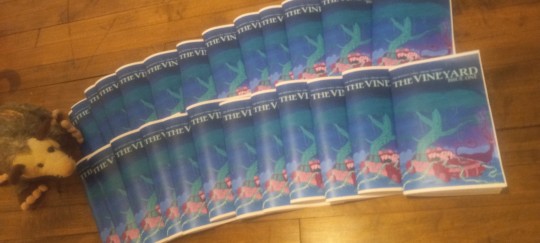
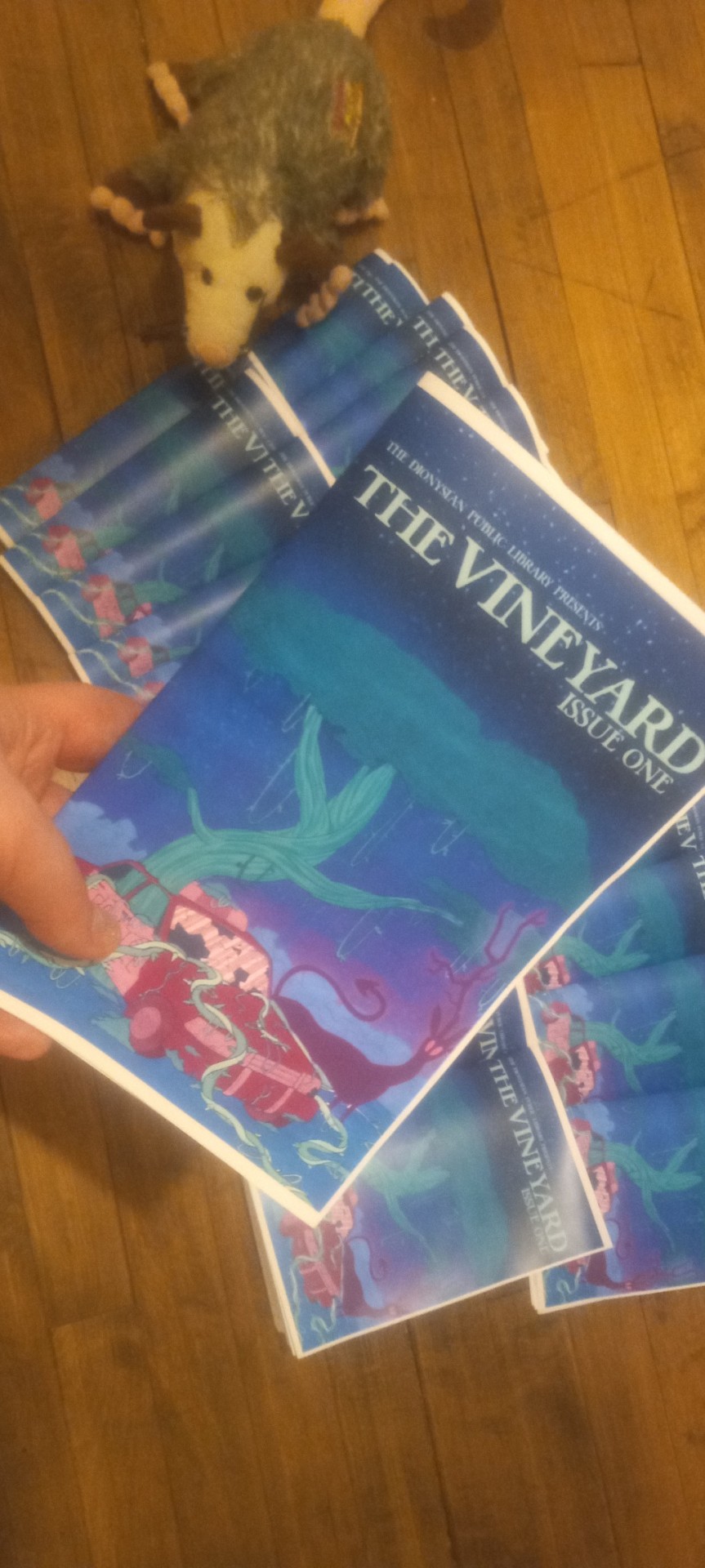
1 note
·
View note
Text
psst go buy my best friend's debut poetry collection

From the Dionysian Public Library comes shimmer, v.f. thompson's debut poetry collection. A meditation on change, transition, what it means to both be and become, thompson draws inspiration from psychedelic and anarchist philosophy, speculative fiction, and the natural world to weave a rich tapestry of imagery and emotion. Covering her year-and-a-half in a house that changed her mind and broke her spirit, it chronicles her journey from who she was to who she will become.
get it here!
39 notes
·
View notes
Text
what is a clean girl?
Being a woman on the internet these days involves parsing a glut of aesthetic micro-trends that crop up on social media. These fashion, beauty and lifestyle inclinations are powered by TikTok, written up by the three or four 'culture' websites we have left, then mocked or glorified accordingly on Twitter and beyond. Examples: cottagecore (wearing a peasant dress in a garden), dark academia (wearing a tweed blazer in a library), and night luxe (wearing a little black dress at a fancy restaurant).
The current one I am seeing bubbling up is something called "clean girl" aesthetic, which to my increasingly geriatric eye appears as young women aiming for a certain kind of effortless-looking but secretly fussy minimalism in their clothing, makeup, and home decor. One of the names of the Alcoholics Anonymous groups that David Foster Wallace details in Infinite Jest is called "Advanced Basics," and this is also how I would describe my impression of the whole "clean girl" thing.
A girl sits at home with an artful latte or glass of wine, her room immaculate, her hair straight and shiny, her clothing patternless and neutral-colored. She is aware that the concept of turning your life into a Pinterest board seems silly to outsiders, but is nevertheless committed to the lifestyle. Because the clean girl lifestyle is a panacea for this modern girl: the required organization eases her mind, and the visual appeal garners her account many likes and follows, which are extremely valuable currency.

I'm inclined to roll my eyes at any trend that requires a great deal of time, money and effort to look effortless and appealing. Ah shit, I think, yet another way to capitalize on the insecurities of The Youth so that companies selling garbage can print money. But the more I think about it, it seems less like a cynical top-down corporate cash grab, and more like a self-soothing lifestyle for a particularly crappy-feeling time in history.
I worked at a wellness website for several years as the girlboss era was reaching its zenith, and a lot of the subtext of what the wellness world was selling back then was "do a 10-step skincare routine, buy an expensive yoga mat, line your windowsill with crystals and regularly cleanse your air with sage and drink a reishi latte every day and then you will feel fulfilled and sleep better and be less anxious." And I'd create content with this subtext in mind, knowing full well that a much better way to combat the stress, anxiety, and fatigue plaguing the wellness-seeking women of the day would be something like giving everyone universal healthcare.

So: "clean girl" is obviously catnip for the TikTok algorithms that favor young thin zitless white women dancing to music, and soon it will also get shoveled like coal into the outrage furnace of Twitter. But I want to look at it with at least some kind of sense of empathy, because I think a lot of these aesthetic micro-trends are the current young generation's attempt to feel some kind of control in an out-of-control world, at an out-of-control time in personal and social development. (The flip-side of "clean girl" is probably the "feral club rat," skulking around at night in broken PVC heels, grasping a dollar slice and a nip of Cuervo, making up for lost Covid time, foregoing any sense of control in favor of Dionysian abandon.)
I don't think there's anything wrong with having a penchant for bullet journaling and plain gold jewelry and making sense of oneself through that kind of consumption and presentation. It's just too bad that these mimetic aesthetics require public posting, and therefore public feedback and public backlash, and then it all just turns into grist for someone else's content mill. Once upon a time I adhered to regimes dictated to me by teen magazines: 10-day ab challenges, back-to-school countdowns that had specific instructions on when to shave your armpits. But I did it all in my room alone and no one saw me do it. God, what would I do if I were young now? How many third parties would profit off my quest for beauty and coherence?
67 notes
·
View notes
Text
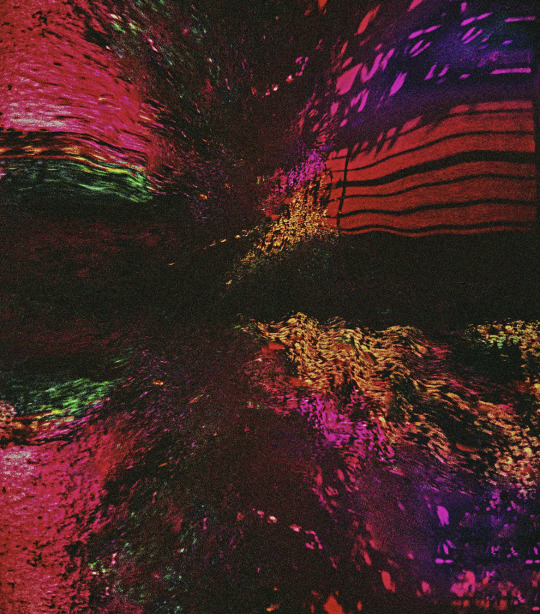
“Solar Grief” — Digital Art (2021) by Ami J. Sanghvi
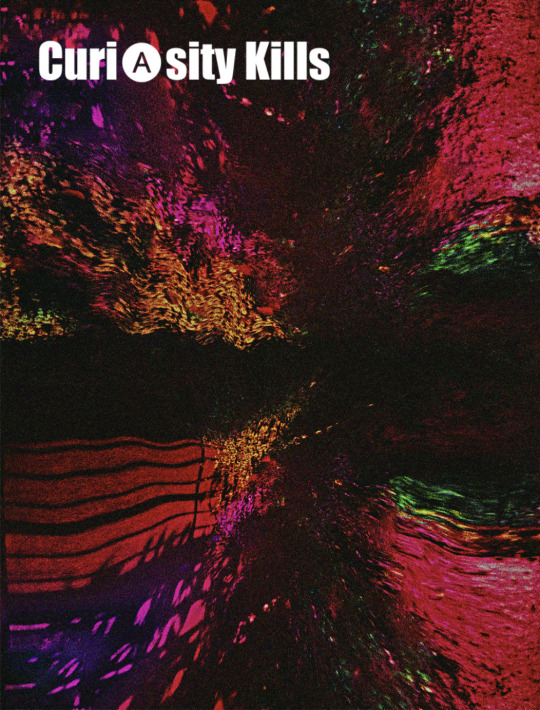
Published in Curi🅐sity Kills Anthology (Compiled & Edited by v.f. Thompson) // Cover Art for Curi🅐sity Kills Anthology — February 2022 (Published and distributed by the Dionysian Public Library)
#cover art#anti capitalism#anti capitalist#capitalist society#capitalist hell#digital art#cover artist#support indie#support indie artists#indie art#experimental art#experimental#solar power#solar#leo sun#leo rising#leo art#global warming#liminalchaos#climate chaos#sun lover#climate activism#climate change#climate catastrophe#climate politics#political#leftist#leftblr#leftist art#visual art
20 notes
·
View notes
Text
StLSPExpo 2018 // Kadak Exhibitor:Diana H Chu
Diana H. Chu is an illustrator, designer, and zinester in Milwaukee. She explores the duality of chaos/order by experimenting with color and poetry on the printed page. Diana’s cut + paste aesthetic leverages analog media and a highly intuitive process. Her illustrations have been recognized by the Society of Illustrators and American Illustration. Diana was interviewed by Business of Fashion during her past-life as an art director and prop stylist.
🔖 cargocollective.com/dianadraws

No Mames Guey
Deluxe poetry & art zine featuring vignettes from the artist’s 9-state road trip from Baltimore to Salt Lake City (and back!) during the summer of 2017. Collage, film-photography and passages typewritten on a 1940’s Corona.
.
.

‘Cloud House’
Deluxe poetry & art zine, detailing a psychedelic experience in the woods of Wisconsin.
.
.

Woolies
Did you know that woollybears morph into Isabella tiger moths? And as adults, they live for only a few days, spending their final hours questing for romance? This deluxe art zine is about the bittersweet romance of nature. It asks questions about how to live mindfully and live in the now.
.
.
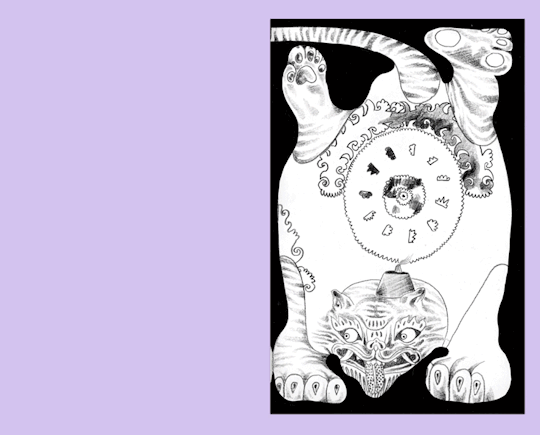
Sudden Death
Deluxe poetry & art zine. Cut & paste aesthetic + tiger rugs and all things mystical.
.
.
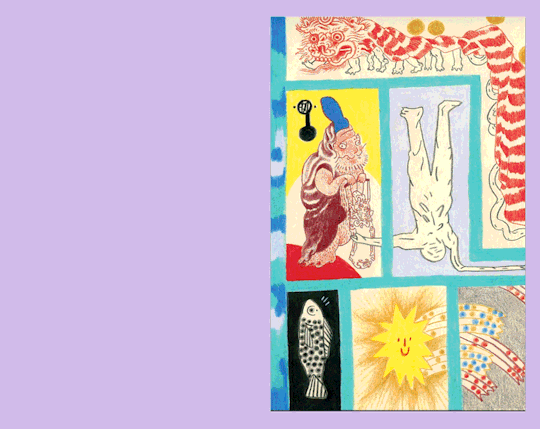
Where Everything is Music
Deluxe poetry & art zine about the Dionysian energy of music. Inspired by the farewell concert of Baltimore’s own Sun Club band, this is a wordless experimental comic that comes replete with a code & cipher that reveals poetry by Rumi. Ancient words + contemporary music + universal feeling.

Le Extraño
Alternative comic about the phenomenon of forgetting what you look like after watching a movie.
.
.

Rodin du Jour
A fun lil’ art zine that makes visual-pun mash-ups of pop culture (The Weeknd, The Big Lebowski, Queen Bey) with Rodin’s drippy, strange & gestural sculptures. For all Rodin fans out there, this one’s for you.
*
We will be at the St Louis Small Press Expo
Oct 13, 10 am-5pm
at St Louis Public Library,
👀 you soon!
1 note
·
View note
Text
The Ultimate Freemasonry Library ** A Unique Collection of 12 Books ** - Publish This
The Ultimate Freemasonry Library ** A Unique Collection of 12 Books **
Publish This
Genre: Social Science
Price: $0.99
Publish Date: March 15, 2011
Publisher: Publish This, LLC
Seller: Publish This, LLC
This Book is a Unique collection of editions of core texts on Freemasonry in the public domain, presented complete and unaltered. Book-1 The Dionysian Artificers by Hippolyto Joseph da Costa [1820] An essay by one of the pioneers of Freemasonry on an important ancient mystery religion. Book-2 Illustrations of Masonry by William Morgan [1827] An early 19th century account of Freemasonry which inspired a great deal of controversy. Book-3 Duncan's Masonic Ritual and Monitor by Malcolm C. Duncan [1866] A comprehensive guide to York rite Freemasonry, including details of ceremonies, grips and passwords, extensively illustrated. Book-4 General Ahiman Rezon by Daniel Sickels [1868] One of the most sought-after Masonic collections, with descriptions of ceremonies, hymns, building dedications, funerals, and more. Book-5 Morals and Dogma by Albert Pike [1871] Albert Pikes' magnum opus; a advanced textbook of the esoteric basis of Freemasonry. Book-6 Devil Worship in France by A.E. Waite [1882] Waite debunks the notorious Taxil hoax which falsely accused Freemasons of worshipping the Devil. Book-7 The Symbolism of Freemasonry by Albert G. Mackey [1882] Book-8 Shibboleth: A Templar Monitor by George Cooper Connor [1894] A Masonic organization modeled after the Templars of old Book-9 The Builders by Joseph Fort Newton [1914] One of the most readable introductions to Masonic history and philosophy, including (for once) a factual account of how Freemasonry emerged in the 18th century. Book-10 The Meaning of Masonry by W. L. Wilmshurst [1922] A look inside the symbolism of Masonry. Book-11 Symbolical Masonry by H. L. Haywood [1923] A study guide to the history and symbolism of Freemasonry. Book-12 The Official Monitor of the Grand Lodge of Ancient Free and Accepted Masons, State of Texas [1922] Details of important Masonic rituals, including initiations for the first three degrees, installation of a lodge, and a Masonic burial service. http://dlvr.it/R3n9ZZ
0 notes
Text
TOM WOLFE: ‘The Right Stuff’ Lands in the Old Campus Center Oak Room
By Philip Eliasoph, PhD
Professor of Art History & Visual Culture, Dept of Visual & Performing Arts

With the passing of Tom Wolfe, the literary lion who died on May 14, I experienced an entangled helix of emotions. One strand within my emotional DNA is a woebegone impact of this tremendously large gap as the 88 year-old prophet became ‘of the ages.’
But any smidgen of mourning was swiftly overtaken. Face to face with his sparkling blue eyes and impish smile, one marinates in a glowing gratitude. On one spring evening over 30 years ago, our campus embraced the knowledge and celebratory realization of Wolfe’s iconoclastic contributions to American culture.
Wolfe’s unparalleled efflorescence, baroque machine gun styled prose, and self-effacing sense of style will live on. One can take solace in realizing his well- earned fame will outlive the copyright expiration of his best sellers and countless articles.
In an endless streaming spate of flesh ripping criticism peppered with belly laughs, he probed deeply into our national psyche shredding Americans’ pretenses and foibles into sardonic sausage slices. A latter-day St. Ignatius thrusting his readers into the process of Examen, he reflected how Americans hope to imagine their lives versus the gritty realities of our indulgences, excesses, and super-duper pomposities.
In a lightning bolt of refracted memory, I recalled our telephone conversation inviting him to speak at Fairfield on April 2, 1987 inaugurating the College of Arts & Sciences newly founded Humanities Lecture Series. Along with Metropolitan Opera prima donna Beverly Sills, we were exploring ‘Creativity and the Arts in America.’
I began to devour Wolfe’s Balzac-esque columns in 1962 in the now extinct New York Herald Tribune. As an acerbic observer with a razor-sharp edge and member of the golden age of the ‘New Journalism,’ he was our perfect choice to kick off our Humanities lectures.
Doing some cerebral spelunking, I pulled from the [perfectly organized] vaults of the DiMenna-Nyselius Library archive a digital ghost of ‘The MIRROR’. The front page header of the April 9 issue duly reported: “Wolfe Speaks About Modern Art in a Modern World.” Wolfe resplendently arrived at the old Campus Center’s Oak Room to enthrall, entertain and prick the conscience of a packed house.
Veteran alumni might fondly recall that the Oak Room was ‘back in the day’—pre -age 21 alcohol laws—the venue for many free-flowing, ‘all the beer you can drink’ Dionysian evenings. I was worried that Mr. Wolfe’s olfactory glands might be overwhelmed by the literally beer-soaked oak paneled walls and stained floors.
Earning his American Studies PhD at Yale in 1957, Wolfe was well positioned to become a contemporary Thackery exposing Wall Street’s greed and the art world’s flimflam inner workings. The MIRROR’s student Editor-in-Chief, Ms. Melissa Campanelli ’87 captured the gist of his talk.
Citing the arrival of Pop and Minimalist trends—the newest avant-gardes for his take down book on the merchandized Manhattan art world—The Painted Word(1975)—Campanelli explained: “Herein lies the theme of Wolfe’s speech. In some instances, the Modern Art World, in all its glamour, has become a religious sect.” And rather cogently, our senior reporter summed his talk up rather brilliantly: “while society is victim to the craft of the artist, the artist is also a victim of the very society he corrupts.” Whew!
“So, Mr. Wolfe,” I probed nervously on the phone with amateurish negotiating skills, “can you promise that when you come to our campus, can you wear your distinctive white three-piece suit?” Without missing a beat, he whispered back, “of course professor—that’s my public identity.” In fact, Assistant Vice President Jim Fitzpatrick’70 states: “I do not remember much about that evening except his suit—and realizing he surely was one of the greatest writers of the 20thcentury!”
Indeed, he was much more than just a rococo exemplar of sartorial excess mixed with his Beau Brummel silk hats, spats, and pinstriped shirts. He self-described his frippery as: “Neo-pretentious.”
Through a glass darkly, cherishing the happiest and most fond memories of that remarkable evening I was privileged to host the great Tom Wolfe at Fairfield, let’s keep his literary legacy ablaze. Years later, I was also given the honor to host William F. Buckley on the newly opened stage of the Quick Center in the early years of the Open Visions Forum. I felt a palpable link among these linguistic titans.
Let’s invoke the accolade given by the hyperbolic Buckley who wrote of his admiration of Tom Wolfe in the conservative National Review:“He is probably the most skillful writer in America—I mean by that he can do more things with words than anyone else.” And who can gainsay him?
0 notes
Note
could i possibly have any good (preferebly free :/ ) resources on the ancient greek mystery religions and how they worked? also on the religous syncretism in that part of the world during the rise of christianity?
Oh man, you have no idea how much I love this question.
[if anyone has trouble seeing or accessing the links, please let me know]
Okay, so first and foremost, there were a lot of Greek mystery cults. Like, a lot. Plus there were the variouscults for foreign deities (such as Cybele) who were adopted by the Greeks, andthose which were originally Hellenic but later subsumed into Imperial Romanreligion (where, for example, Isis and Osiris became incredibly popular) andspread across Europe. So like, if you have more specific questions (either interms of particular deities or points in time) then I can dig up resourcescatered to that.
Also, due to the whole “mystery” part of mystery religion, there’svery little which is universally agreed upon, and there’s a great deal that we’llprobably never know. Personally,though I find this topic fascinating and I myself ascribe to and utilizeportions of Orphism in my practice, I think there’s usually little point inattempting to incorporate the ancient mysteries into one’s modern practice. ButI assume you’re asking more out of interest’s sake, and I certainly share thatinterest, so for now just an overview:
Unfortunately it’s pretty difficult to get newer sources andresearch for free online (I’m talking more recent than the early 60’s) that isn’tjust bare-bones info, but that’s not to say there’s none.
Encyclopedia Brittanica has a good summary of Hellenic and Hellenistic mystery cults, including the Dionysian,Eleusinian, and Orphic Mysteries. The Met. Museum has a collection of essays about various cults in ancient Greece and Rome, about Classical Greek religion and the afterlife(here and here,respectively), and Roman Mithraism,as well as several others about ancient art, music, and trade, which lookinteresting.
Theoi.com is, as always, an excellent resource and discussesthe Samothracian, Orphic,Arcadian,and Eleusinian Mysteries.
Sacred-texts.com is another good site (albeit a bit hard tonavigate sometimes), though the sources are quite dated just by nature of whatthey’re doing over there (namely collecting early scholarly, esoteric, and historicalworks which contributed to human knowledge in some manner). Nonetheless, youcan take a look at Thomas Taylor’s interpretation of the ancient mysteries.
Books unfortunately are only free if you have access to auniversity library (though public libraries may have some of these as well) or if you can find excerpts on Google Books or similar sites (which vary in completeness), but I’llinclude a few nonetheless.
Placing the Gods: Sanctuaries and Sacred Space in AncientGreece, An Archaeology of Ancestors: Tomb Cult and Hero Cult in Early Greece, andHomo Necans. The Anthropology of Ancient Greek Sacrificial Ritual and Myth are primarily general and background information, but are great places to start. Again, if you’re interested in particular deities orcultic practices I can direct you to sources specifically about them. My ownpet projects are Orphism, Orphic Bacchism, Sabazios, the Thracian horseman,and the Samothracian and Dionysian Mysteries, so I’ll be most helpful there.
As for your second question, I’m not sure if you meantsyncretism with Christianity or justin the era of Christianity, buteither way this is a fairly under-researched topic (hell, it’s hard enough toget a handle on Ptolemaic and Roman syncretism when primary written sources arealmost hypersyncretic, in that contemporarywriters use familiar local names for foreign deities in order to appeal totheir readers, even when said deities may not be very similar or ever have beenworshipped in a syncretized manner). Further, because Greece belonged to theRoman Empire at the time of Christianity and Hellenic culture had long sincebeen subsumed, this gets a little out of my realm of expertise (not to mentionconfusing). So if Mod Evodije has anything to add on that front they’re morethan welcome.
That said, I can tell you that gnostic Christianity shared alot of similarities with pre-Christian mystery religions (especially Orphism),so that might be something to look into. I’ve also read Pilgrimage inGraeco-Roman and Early Christian Antiquity: Seeing the Gods, which compares andcontrasts personal and collective religious practice in Hellenistic Greece, theRoman Empire, Judaism, and early Christianity. It doesn’t discuss syncretism in so many words, but you can definitely see the influence of late antiquity on early Christianity (it also seems pretty difficult to get ahold of, so if you’re super keen on it message me here or at my personal blog and I can see about sending you a few chapters). There are also books and articles written by Biblical scholars, such as Christianity in the Greco-Roman World, which obviously come from a more Christianised perspective and have a different focus but may contain some of what you’re looking for.
That’s about all I have at the moment, but you can alwayscome back and clarify and I can give you more info, or do some more researchabout stuff I’m less familiar with. Hope that gives you something to startwith, at any rate!
- Mod Jasper
40 notes
·
View notes
Text
Tragedy as the Joyful Art; or, The Ironic Art of Tragedy
I took this photograph in April of last year. This is the first permanent theatre ever built in the world, where some of my favourite plays were performed for the very first time. The original site where all the formality of what we know as theatre had its origins. It was also a civic art, created simultaneously with democracy, where public speaking and talking about their lives was so important. And the most important site during the festival of Dionysia. I went to Athens to read the plays sitting in the theatre seats that someone sat in watching these very plays 2,500 years ago.I think Greek tragedy is the greatest artform and the greatest approach to art there ever was. I’ve been studying and writing about it for ten years. Meeting with scholars and practitioners of theatre. Learning from so many books, talks, and documentaries. And testing out my understanding in writing my own work across stage, books, and poetry. As well as hiring art spaces out to staging some of my own performances.This is an artform that demonstrates the power of art. It’s an artform of immense passion for life, and demands its artist a great capacity for comprehending reality with all its good and bad qualities. Tragedy was no art of optimism, nor was it mere melodrama, and certainly it wasn’t grave liturgical passion plays. Tragedy is more than a genre, it's a world view. And so its technique has to be in-keeping with that world view.Over the centuries we have corroded the original meaning of tragedy. We associate tragedy with death, but not a single tragic hero dies in any of Aeschylus' best plays. And, with the exception of Ajax’s suicide, not one tragic figure dies on stage. There was no pleasure taken from death in this theatre. Its about a dilemma of existence. Its an art that's been misunderstood and has been misunderstood since Aristotle. Aristotle thought the objective was to arouse pity and fear, and produce a cathartic effect from being overwhelmed by them. This is a complete misunderstanding, of both its effect and how the work would arrive on the page at all.It’s evident that original subject matter wasn’t of much importance, since all the tragedians wrote plays on the same subject and characters. What the theatre-maker did with it was what was of importance; what they invested into it; what the play was doing not what it was about. And given these plays were written in the context of a festival competition, it would be befitting that they should write on the same subject, so that their works could go head to head, as competition was everything to the Ancient Greeks. “potter strives against potter, craftsman strives against craftsman, singer strives against singer” writes Hesiod in the Works and Days. “Strife is justice” writes Heraclitus.But even the Greeks lost their way. Euripides turned tragedy into mere melodrama, Aristotle misunderstood it and ruined an understanding for centuries. The Romans didn’t know how to handle it correctly. When the Christians revived theatre as instruction of the Bible to the illiterate they turned tragedy into its present meaning. Even Nietzsche blundered aspects of it with his loony Dionysian-Apollonian dichotomy. Shakespeare borrowed from conventions unGreek, such as the Christian medieval passion plays of Christ’s crucifixion which featured enduring suffering and death on stage. Roman tragedies of Seneca that were pathos of suffering and revenge. And the comedies of antiquity which he borrowed their oscillation between protagonist and antagonist. Even the idea of the fall of heights comes from a medieval concept of the wheel of fortune. And if you combine these with Aristotle’s misinterpretations and Euripides’ melodrama, given his work survives more than any other tragedian, then our general understanding is naturally inaccurate. All in all, we’re just missing the point, and our understanding doesn’t do justice or describe any of the examples of what is going on in any of the earliest extant works of tragedy by Aeschylus, whom even in his own time was considered the greatest of the three surviving tragedians. The comic playwright Aristophanes, just after the death of Euripides, wrote a play called The Frogs wherein the patron god of theatre, Dionysus, goes to the underworld to bring back one of the three playwrights because tragedy has fallen to a terrible standard since they’ve died. Sophocles umpires whilst Aeschylus and Euripides have a kind of literary criticism competition, lampooning each others works, and in the end Aeschylus wins.When we think of this art being created, the rules for this aren't coming from literary criticism. So the rules for these works were born from their culture. Real Tragedy rose and fell in its richest form, much like what happens with our popular culture. It doesn’t seem to have been based around hard and fast rules, as with Japanese Noh Drama that keeps to its tradition. These were not professional playwrights. Theatre had only just been invented merely decades earlier (albeit in the previous century). But it had reached a refined and sophisticated brilliance, much like cinema in the sixties and seventies had done merely decades from the birth of cinema. For the same reason that we have culture of the eighties, nineties, twenty-tens, etc, the meaning of art changes. This is little or nothing to do with progress, politics, or technology, except as being part and parcel of that same consequence. As the prevailing condition of human character changes, the disposition to the world by the artist changes, both artists and in audience. The change in tragedy came with Socrates. With Socrates came rationalism, and with rationalism came optimism, and with optimism came cheerfulness, with cheerfulness comes attitudes to life of consolation, with consolation comes defensive doctrine of morality. It was this new scientific attitude that took hold of Athenian culture that was the prime symptom of the demise of real Greek tragedy. An attitude that stands in opposition to the embryonic pregnancy of how tragedy can be conceived. Not only Socratic influence in the case of Euripides’ work, but this was the age of Plato, which it is agreed upon, is a philosophy that is wholly proto-Christian, and significant to the development of Christianity by Neo-Plantonist Jews who studied his works in the Library of Alexandria. This is not all too dissimilar from the Puritanical, rationalistic and scientific age of Enlightenment that followed the period of Shakespearean tragedy.The art of tragedy differs also from our very familiarity with the presentation of theatre itself. Not only was this not a naturalistic theatre, but more stylised than even the mannerisms of opera, more in fact like the movements of a puppet theatre, the dancing of African and Indian dances, and the music of medieval secular music and our popular music, to the degree that our Modern theatre cannot be used as a frame of reference at all. If an ancient Athenian were to sit in our theatres of tragedy they would either be wholly confused or roll about laughing. It’s important to remember that Ancient Greece was a culture that looked East, and were influenced by world views and religions of the East. How sterile and cold a Modern Western European culture feels when held next to Ancient Greece, with its almost colourfully Brahmic culture. Two-thousand years of Christian Europe has lead to a lot of misunderstandings.Pageant wagons depicting scenes from the Bible were the first cinema or TV screens. They would roll through the town like a float parade representing the whole universe of the Bible. They were literally a window to the world, which incorporated all the people of the world and beyond it, whilst the audience watched, removed from its settings.This was not what tragedy was doing. Tragedy was a superimposed performance into a very real world, which didn’t have a metaphysical beyond. Olympus and the Underworld are in this one and the same world. The performances themselves were of, not Athens, but of real cities. Their plays consisted of characters absent, conjured by theatre, but the rest of the world consisted of those in the audience watching and this very same real world. The characters were not rolled out, being born from trying to re-present the world realistically, but born from a realm of poetry, with only three characters on stage at one time. The necessity of characters merely to move plot forward by bringing in new information, not because that’s how the world looks. It’s believed the first tragedies would have been only one actor and a chorus of fifty singers. Although limited, this must have a powerful kind of poetry-performance-art-music-dance-drama. The speech is stylised and poetic. compared to our modern theatre, since we see the stage as a re-presentation of a window to the world, writers naturally concluded why don’t people in the play talk like they do outside our windows, and ordinary realistic speech was pushed onto the stage. But again, we’re just missing the point. This was not a projected window to the universe, nor was it to be held up like a mirror to ordinary life. This was a drama of poetry-music performance art. The poet was by nature also a musician in these dramas, and in the case of Choral poetry, which was so integral to tragedy, a poet-musician-dancer. But the Greeks were not pessimistic. The Greeks didn’t underestimate the power of poetry and music. The tragic heroes were not poets but they were endowed with poetic abilities. The model for a poet was Orpheus who could transform the world around him with song and music, could make birds sing, and fish leap out of water. Just as the poet suffered in life they were also considered to posses divine abilities by the effect of poetry on others, and subsequently were mythologised. This was not a re-presentation of the world. This was an art. The very drama of tragedy is born from the intoxicating rapture of music and poetry, not only in to a vision of scenes, but the drama and all it contains that unfolds. The choral separations between “acts” are to reenergise the drama with its original intoxication for the drama to then spring from. The drama springs from the music, the character embodied by the poetry. Breaking up apart from out civilised cultural self into our primal nature and rebuilding into a character who cab stand in a world of such a reality, in a cycle of creative destruction. Think of that two minutes as Friends begins followed by the theme song, narrating the themes of the show, and then the acting resumes. It’s not all together different from what happens there. A pop rock quiet verse, loud chorus, quiet verse, loud chorus. Or the use of the music of Morricone in Leone's movies, in a Tarantino or Scorsese picture. The moments of talk by a singer between songs. All this is closer to tragedy than opera which literally dramatises action, feeling, words into the music itself. Opera, which is truthfully merely poetry as music, and considered a high art because it was associated with high society, the vogue of intellectual rationalism, and church music - in short, all things which modernity considered to be of refined and sophisticated high class. Modernity is Socratic art par excellence.To understand an art you have to understand the condition of its pregnancy not by its affected reception. You have to view it in embryo and look for under what conditions this would be conceived. If you study it as an afterword there are all sorts of interpretations possible. But if you study it in conception then every interpretation must end with the work. Not how do we analyse the written text as an afterword, but how you go from a blank page to this written text. We need to analyse it as the author not the audience. It's not enough to analyse effects because often the process of creation is inverse to the desired effect they produce. You can have a innumerable interpretations as an audience, but whatever interpretations you have here, all end with this. And if you apply those rules to a blank page you should end with the work too. Until I can fake a Greek play, I haven’t understood it.Challenges are what make us grow, are what make us demonstrate our outstanding qualities, and create goals which give our lives meaning. How do you give life meaning when it's full of horrible things that are hard to comprehend? It's normal that we prefer to want to live in a world of a limited amount of perception about the nature of ourselves and the world we live in. Or live optimistically and pretend that negative consequences are not likely to happen, that in the end everything works out. We prefer, not to live in a world of those difficult realities, but a world that consoles us for those things. And we put blinkers on and black-out just enough of reality so we can enjoy living in it. That can't happen in tragedy. It demands you to take in all the difficult things to comprehend about the world as a reality of lifeIn a similar way to how a pop or rock singer will sing a lyric contrary to its written expression, joyfully singing a sad lyric. And how an actor playing a villain doesn’t play the role as the audience feels about the character, but how the character feels about themselves, so to play the role convincingly they have to play the bad guy as a good guy. Tragedy is an art of irony. And irony is the essence of all great art. It sets up its pessimism and overcomes it with art. Pain shuts down language. It is such an intransitive experience that it is near impossible to express in language. Pain is the flip-side to imagination, and as such then is pain overcome by pure creative force. Pessimism is overcome by the creative act of poetry, that has a diction too strong to succumb to the very subject of their expression, overcome by their musicality and metaphorical beauty. What was pain is overcome by the power of art. Art, which stands beyond the reach of intransitive pain and suffering. And yet has by the very nature of art sprung from them, affirmed that very aspect of life which contains pain and suffering. Pessimism in the audience is overcome by the experience of the plays, of beautiful lyrical speech, the ecstasy music and dancing, performing to a collected public audience not in the dark but in the midday spring sun when everything was undergoing regeneration, in the context of a festival of wine and sex, devoted to the god Dionysus who embodied ecstasy and liberation from gloomy cares and worry. By allowing an audience to revel and feel exhilaration in a scenario of this scope of reality and spectrum of being a human being. When pain and suffering is universalised in to a collective experience being human, and again overcome by a collective experience of art. Similar to a crowd listening to an anthemic rock song all singing at the same time, liberated and reunited with that primal human being that lurks behind the overbearing cultural citizen who exists in daily civilization.Unnaturalness is the essence of archaic art because it shows the defiance of art in the face of aspects of life that would ordinarily make us gloomy. Tragedy was life affirming because it did not turn away from life. Some of the most similar examples of its technique are not from the renaissance, neo-classicalism, the opera, the Romans, but from the twentieth century. This was the pop culture of the American 1990s. This whole approach of popular culture from the 60s to the 90s. This was the art of Spain in the early twentieth century. This was some of the work of Italy and Japan. The rock music of England. The atmosphere of the Olympics, the superbowl, Glastonbury festival. Although tragedy and comedy were not mixed genres, there was no differentiation between high and popular art in Ancient Greece. Tragedy contained the popular arts we're familiar with today, and all the wisdom of Aristophanes' comedy was punctuated with fart jokes. Greek tragedy is high art popular culture.All great periods of art were during undesirable political times. The antagonism is a positive one. It shows the defiance in the power of art over aspects of life that make us gloomy. The whole objective was that pain and suffering, where a stimulant for overcoming, and therefore affirmed into the whole theatre of life, the whole horror of existence was overcome by art. This was an exhilarating joyful art. It was life affirming because it did not turn away from life. Not to use art to talk about the terribleness of the world but to use it as weights that test our strength for loving life even in that reality of the world. Like a weight lifter's strong arm that needs heavier things to test their strength. The Greeks used art to lift the heaviness of life. This was done in competition. This was the stage where the Greeks competed to demonstrate who loves life the most. That’s what I feel art is, the myth over the reality, an illusion we place over the world in order to love it more.
0 notes
Text
howdy, tumblr!
we're the Dionysian Public Library, a multimedia arts collective focused on d.i.y. print media and live performance. the first issue of our biannual zine, The Vineyard, will be out tomorrow
excited to be here here on blue hell
find us at www.dionysianpubliclibrary.com for more information
6 notes
·
View notes
Text
so i made a new blog
yo, what up gamers
i used to be @peachy-keen-glam-queen, but decided rather than revamp my old blog i just wanted a fresh start.
i'm a writer, primarily of horror, as well as a clown and editor at The Dionysian Public Library.
i'm rejoining the site to engage with writing, books, and comics, as well as kind of just to see what what happens
happy to be here. let's see where this goes.
1 note
·
View note
Text
Yearly Calendar Excel
The device stayed in usage throughout the first medieval period of time prior to the wide spread adoption two months calendar of this Dionysian age at the Carolingian span . From the Roman Empire, the AUC season Might Be Used alongside the prior Calendar Year, so the consulship of both Quintus Fufius Calenus along with Publius Vatinius may be ascertained as 707 AUC (or even 4-7 B C ), the third largest consulship of both Caius Julius Caesar, together with Marcus Aemilius Lepidus, as 708 AUC (or even 4 6 B C ), and also the fourth largest consulship of Gaius Julius Caesar as 709 AUC (or even 4 5 B C ). [1 1 ]The seven-day Week includes a heritage reaching back into the Historic Near East, nevertheless the introduction of this"planetary week" which continues to be in present day usage dates into the Roman Empire span (see too titles of those occasions of this week).
The webpage for May Possibly three months calendar from the Bedford Psalter and Outcomes ms. (British Library Insert M-S 42131, fol. 3 R, ancient 15th century)For its very first six decades because the arrival Of all Jesus Christ, European states utilised various regional approaches to count on decades, many normally regnal years now , modeled over the outdated Testament. [1 1 ] in a few instances, Generation dating was likewise utilized. [1 1 ] From the 8th century, also the most anglo saxon historian Bede the Venerable utilised the following Latin word,"ante uero incarnationis dominicae tempus" ("enough full time before god's authentic incarnation", comparable to this Language "before Christ"), to name decades before the very first period with this age. [2 3 ]
According for the Catholic public holiday calendar Encyclopedia, also Popes lasted thus far records According to regnal many years , also using A-D merely gradually grew to become prevalent in Europe from the 11th to the 14th centuries. [citation had ] Back in 1422,'' Portugal grew to become the previous european region to embrace exactly the Anno Domini technique. [citation had ]
0 notes
Text
Hyperallergic: How Coloring Books Can Teach Us About Diversity in Ancient Times
A mosaic of a Dionysian scene originally from the Italian port of Ostia (2nd c. CE), now at the Staatliche Museen zu Berlin (screenshot by the author for Hyperallergic)
In a previous piece on ancient polychromy for Hyperallergic, I discussed how certain alt-right groups had begun to appropriate marble sculpture of the classical world as symbolic of white European superiority, when in fact most white statues were in antiquity were painted. The piece caused some controversy, to say the least. Although it was misconstrued by some as an accusation that all white statues were inherently racist, the article was in fact meant to recognize that art historical interpretations of artwork have the power to influence the way individual people, groups, and entire fields of study define beauty. In the piece, I suggested that museums could return color to the ancient world by using new projection-mapping techniques to colorize ancient objects (as practiced on the Ara Pacis in Rome or frequently used on the Egyptian reliefs at the Metropolitan Museum of Art in New York) and to embrace the use of 3D modeling in museum displays. What I had not considered was a more analog approach to learning about ancient polychromy: the coloring book.
A reconstructed Romanesque polychrome simulation of a fragment from the 13th-century stone portico at Santa Maria de Vilagrassa (Sketchfab 3D model by Josep Giribet)
In recent years, adult coloring books have become all the rage — to the point where the thought of one more might make us a little nauseous. But if we consider coloring books as pedagogical tools rather than an amusing activity to partake in while waiting for brunch, we can perhaps use the fad as food for thought. It is not as though museums and libraries haven’t already thought of this. The Twitter hashtag #ColorOurCollections has encouraged everyone from the Vatican to the University of Iowa libraries to produce open-access coloring pages that allow people to better interact with museum collections, archives, and cultural heritage. But there is something special about highlighting student artists — rather than curators, professors, or professionals — who have taken this idea into their own hands.
Students at the RISD Museum Summer Teen Intensive Workshop display their final project, a coloring book on ancient polychromy
At the Rhode Island School of Design Museum’s 2017 Museum Summer Teen Intensive, curator of ancient art Gina Borromeo met with teens for an 11-day intensive workshop. As recounted in a blog post on the subject, these students increasingly addressed the role of the museum in presenting and interpreting representations of identity, ethnicity, and status to viewers. The discussion shifted to polychromy, and a debate ensued about how the display of reconstructed color can inform museum viewers. For their final project at the workshop, the students produced a coloring book titled Pigments of Your Imagination: A Color Restoration Book, created in conjunction with artist Sonja John. (You can download it as a PDF or view it online.)
The book has a social justice angle that you don’t often find in coloring books centered on the ancient world, although there are others that discuss polychromy. Just a few months ago, classicist Lisa Trentin published a coloring book for adults to learn about polychrome sculpture called Classical Sculpture in Color: An Adult Colouring Book.
Cover of Dr. Lisa Trentin’s Coloring Book on Ancient Polychromy (Twitter image used with the permission of the author)
The book addresses a number of the techniques, reconstructions, and ideas forged by archaeologist Vinzenz Brinkmann and other classicists who are active in reconstructing ancient color. There was also a coloring book on polychromy published by Copenhagen’s Ny Carlsberg Glyptotek museum as part of their Transformations: Classical Sculpture in Colour exhibit, although it is in Danish and could only be bought along with the official catalogue. While both Trentin’s and the Glyptotek’s books are important, having free versions undoubtedly would have allowed for greater public engagement with the ideas they sought to impart.
The first page of Pigments of Your Imagination: A Color Restoration Book provides context for the debate over the paint applied to statues in antiquity
The question of whether we need more educational and interactive material that directly addresses color in the ancient world must be met with an explicit yes. In the past few weeks, this issue has again caused intense — and somewhat malicious — debate in the UK, where a cartoon depicting a dark-skinned Roman father elicited an uproar over whether there truly was diversity in ancient Roman Britannia. Even the well-known (and highly respected) classicist Mary Beard became the target of uninformed criticism and trolling. It is clear that this issue needs clarifying and that it is not going away anytime soon. Even when presented with sculpture, mosaics, frescoes, DNA analysis, and texts that speak to a diverse Mediterranean, many wish to deny it. That’s where modern cartoons, movies, video games, museums, and even coloring books can step in and begin to shift the visual narrative.
The negative backlash I received over the past two months has made me reflect on the fact that when artists or writers release something into the public sphere, they lose control over how it is received, interpreted, manipulated, and remixed. I had largely lamented this fact, but the teens at RISD helped me remember that putting our creations into the world can also have a positive impact. It was also a potent reminder that the next generation is already well informed about these sorts of complex issues and has a hell of a lot to teach us. I, for one, am more than happy to sit down with a box of crayons and learn from them.
The post How Coloring Books Can Teach Us About Diversity in Ancient Times appeared first on Hyperallergic.
from Hyperallergic http://ift.tt/2uvjRzg
via IFTTT
0 notes
Photo
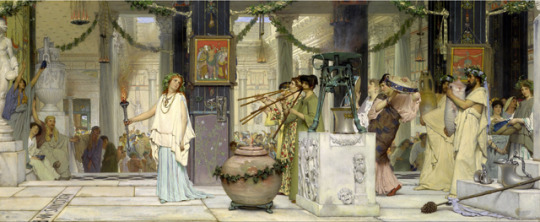
The vintage festival
Lawrence Alma-Tadema 1871
From the collection of
National Gallery of Victoria
Described in the Windsor Magazine in 1896 as ‘a master of white marble and blue skies’, Lawrence Alma- Tadema was renowned for the historical accuracy of his paintings. The vintage festival is set in the villa of Marcus Holconius Rufus, a prominent citizen of Pompeii at the time of that city’s destruction (79 CE). This work is a classic example of the astonishingly vivid recreations of daily life in the ancient Roman and Greek worlds that brought the Dutch-born Alma-Tadema – who had migrated to England from Belgium in 1870 – both critical acclaim and financial security.
A scholar of ancient history, Alma-Tadema has filled this scene of Bacchic revelry – celebrating the fruits of the annual grape harvest – with dozens of lovingly recreated objects from the first century CE, which he had researched with an archaeological precision (he later bequeathed his five-thousand-volume research library to the Victoria and Albert Museum in London). As a critic for the Art Journal wrote of The vintage festival in 1883:
In this elaborate composition the artist has carried archaeological realism to a high degree: witness the straps and bandages which support the flutes at the mouths of the flute-players. The richness and the quantity of the work in this picture are surprising; nevertheless it is full of space, neither the numbers of figures nor the profusion of architectural and other exquisite detail producing any crowd of forms or infelicity of lines. The colour is a splendid combination of richness and radiance, all the loveliness of tint possible to flowers, gold, and marble, silk and rich ivy-leaves, being brought together in a chord of colour that has not the quarter of a semitone astray. (Art Journal, March 1883, p.67)
Alma-Tadema painted two versions of this composition simultaneously: a larger painting (now at the Kunsthalle Hamburg), which was first exhibited at the gallery of the London dealer Ernest Gambart in 1871; and the slightly smaller version (this painting), which was sent to the printer Auguste Blanchard in Paris, to be used as the basis for an engraving. Blanchard’s engraving, published in 1874, served to further familiarize Victorian audiences with Alma-Tadema’s Dionysian depiction of Roman splendour.
Text by Dr Ted Gott from 19th century painting and sculpture in the international collections of the National Gallery of Victoria, National Gallery of Victoria, Melbourne, 2003, p. 69.
Details
Title: The vintage festival
Creator: Lawrence Alma-Tadema
Date Created: 1871
Provenance: Commissioned by Ernest Gambart (1814–1902) (dealer-collector), London and Spa, Belgium, 1871–86 (his private collection); from whom purchased by Thomas Agnew and Sons (dealer), London, 15 July 1886; purchased from Agnew and Sons, by Alfred Taddy Thompson and Sir James McCulloch, for the National Gallery of Victoria, 1888.
Physical Dimensions: w1190 x h510 cm (Unframed)
Type: Paintings
Rights: National Gallery of Victoria, Melbourne Purchased, 1888, © National Gallery of Victoria
External Link: National Gallery of Victoria http://www.ngv.vic.gov.au/col/work/3699
Medium: oil on wood panel
National Gallery of Victoria
Melbourne, Australia
Founded in 1861, the National Gallery of Victoria is Australia’s oldest public art museum with a rich history and world class Collection of over 70,000 works. There are many treasures to be found on the walls of both the Gallery’s sites – NGV International on St. Kilda Road and The Ian Potter Centre: NGV Australia at Federation Square.
NGV International houses the Gallery’s encyclopaedic Collection of International art while The Ian Potter Centre: NGV Australia is home to the Gallery’s comprehensive Australian art Collection, including works by the Aboriginal and Torres Strait Island communities.
The NGV’s marvellous Collection represents the world’s most important art movements across many centuries and cultures. The majority of the Collection has been generously gifted to the NGV by members of the community for everyone to enjoy.
The NGV offers an extraordinary visual arts experience with a diverse range of temporary exhibitions, Collection displays, talks, tours, programs for kids, films, late-night openings and performances.
In 2010 over 1.5 million people visited the NGV.
Lawrence Alma-Tadema
Jan 8, 1836 – Jun 25, 1912
Sir Lawrence Alma-Tadema, OM, RA was a Frisian painter of special British denizenship.
Born in Dronrijp, the Netherlands, and trained at the Royal Academy of Antwerp, Belgium, he settled in England in 1870 and spent the rest of his life there. A classical-subject painter, he became famous for his depictions of the luxury and decadence of the Roman Empire, with languorous figures set in fabulous marbled interiors or against a backdrop of dazzling blue Mediterranean Sea and sky.
Though admired during his lifetime for his draftsmanship and depictions of Classical antiquity, his work fell into disrepute after his death, and only since the 1960s has it been re-evaluated for its importance within nineteenth-century English art.
The vintage festival Lawrence Alma-Tadema 1871 was originally published on HiSoUR Art Collection
0 notes